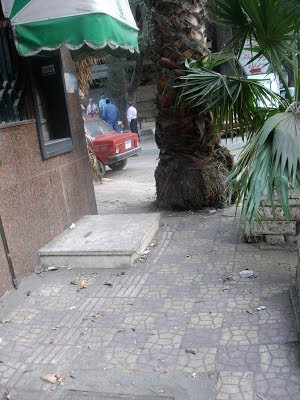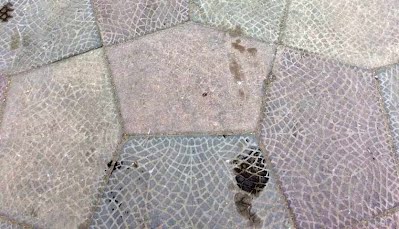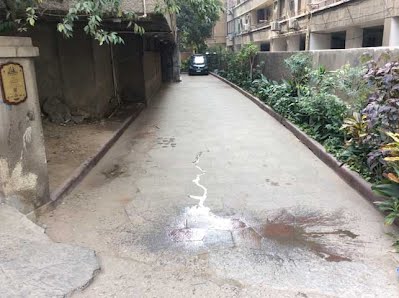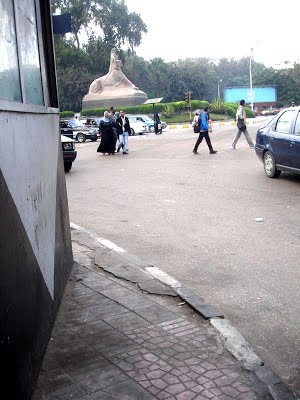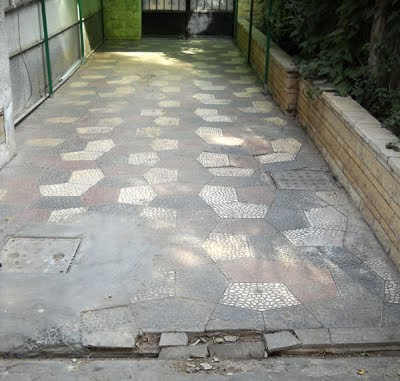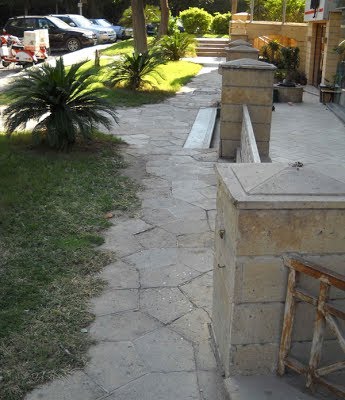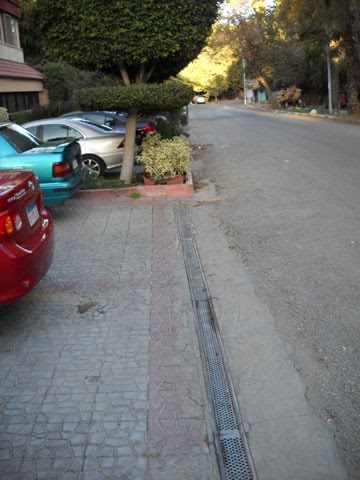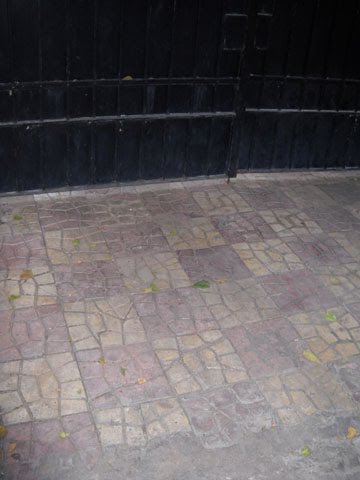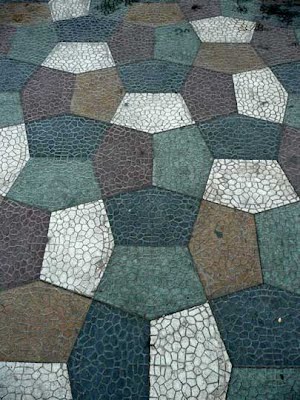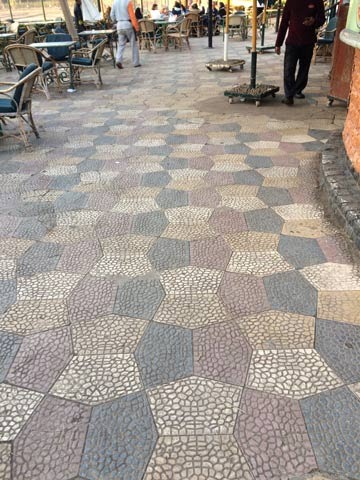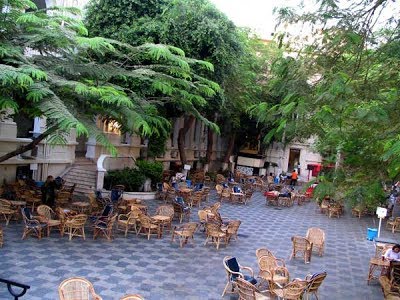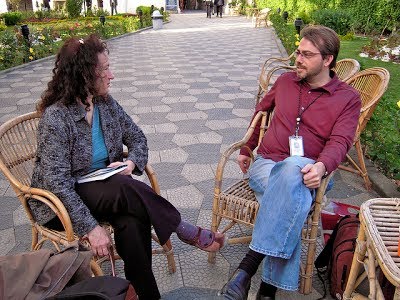Introduction Given the numerous pictures I now have of the tiling, in a variety of places in Cairo, and further afield in Egypt, for the sake of convenience I now separate these as according to that description. ‘Pictures of Sighting 1’
shows instances solely in Cairo and surrounding districts, whilst ‘Pictures of
Sightings 2’ are outside of Cairo, but still in Egypt. A variety of pictures
are shown, generally of the overall view, except on special occasions, rather than a detailed pictures of the paving
units, as anyone detailed picture is very much like another. Various types of sighting are shown, of ad hoc appearances, where these
appear to have simply been used to fill in a missing arbitrary paving and
notable landmarks, such as at the Cairo tower (and everything in-between), and both
extant and no longer in existence. These are shown in alphabetical order for
the sake of general ordering, although category is at whim in places. Where a
sighting is prominent, such as the Cairo tower, this is placed there, rather
than its district (Zamalek). Although broadly the pictures essentially do not
need comment, on occasions this is added to clarify certain aspects, or to discuss
aspects of interest. The sightings vary in
their extent and quality of picture. Some are of just a few of the tiles (Giza Zoo), whilst others are as far as
the eye can see (Gezira Sporting Club), and everything in between. The
sightings are widespread in Cairo, and include: Al-Galaa club, El-Azhar University grounds, Cairo airport, City of the Dead, Dokki, Gezira
Sporting Club, Giza Zoo, Heliopolis, Indian Embassy, Maadi, Manial Palace on Roda Island, The American University in Cairo, and Zamalek. Occasionally,
pictures are not available for copyright reasons, although I still discuss
these (Other reported sightings, such as Cairo airport (no pictures available),
of the City of the Dead (for copyright reasons) are not pictured.)
Pictures of Sightings 1. In Cairo and its Environs (shown alphabetically, albeit somewhat varied in description as to title or location) Al-Galaa club, in Heliopolis, of 1957 Galaa Club, Heliopolis (23 July 1957). Three photos in an album of 3. http://nasser.bibalex.org/Photos/photosmain.aspx?albumId=4100&lang=en Caption: National events and celebrations: Opening the Galaa Club in Heliopolis during the July 23rd Revolution celebrations. The first recorded pictures of the Cairo tiling, at least in situ! A 1957 advert also shows the tiling, in close up, but not (apparently) in situ. The 23rd July is Revolution Day, a public holiday celebrated in Egypt to commemorate the military coup of July 23, 1952, that led to the end of the monarchy and the establishment of an independent republic. The Galaa Club, at Heliopolis, is a famous military club and is still extant, but whether this sighting itself is still extant I have not been able to confirm. But likely now given the passage of time, even more so than others, it is not. There is seemingly little detail available on the club itself. A sighting of the utmost significance is at the Al-Galaa club, in Heliopolis, as this is the earliest documented date, of 1957 (from photographic evidence). The occasion was the opening of the club by President Nasser. Therefore, it would seem unlikely to have been in place previously here. Whether this is still extant is uncertain. Note
that the paving is widely seen in Heliopolis, as discussed below.
Cairo Airport, 1969? Details here are sketchy. This sighting was reported to me by James Dunn, upon my asking for clarifications as to his account of the tiling in the Mathematical Gazette of 1971, upon a 1969 visit. However, there is no documentary evidence of this. Indeed this is now almost certainly no longer extant; the airport has been considerably remodelled since then, with more terminals. Does anyone know of this? Cairo Tower, Gezira Island, of 1961 (Not Extant) Cairo Tower (16 April 1961). Two photos in an album of ten. http://nasser.bibalex.org/Photos/photosmain.aspx?albumId=1145&lang=en Caption: Visit of the wife of Abdel Nasser and the wife of Yugoslav President Joseph Bros. Tito to the Cairo Tower. Cairo Tower (21 April 1961). Four photos in an album of 32. http://nasser.bibalex.org/Photos/photosmain.aspx?albumId=3623&lang=en Caption: President Josip Broz Tito of Yugoslavia visits the Cairo Tower A sighting at the Cairo tower on Gezira island, in 1961 was a spectacular sight, but is unfortunately no longer extant, it having been replaced by plain paving at an unknown date. Possibly this lasted until 2004-2009 when the Cairo tower was restored. Dating this, being a prominent landmark, can be done with a degree of certainty. The pictures show various dignitaries at the opening, with President Nasser and President Tito at the official opening. The Cairo tower was built between 1954 and 1961 (the latter its opening date), and so obviously it was installed sometime of these dates. City
of the Dead, outside a mosque, of 2002
Dokki (Extant) El-Azhar University, 1993 A single sighting, at El-Azhar University, at least of 1993, from a photo in a book. This is just a small patch, and so it is not possible to judge the extent. Is it still there? Garden City, Aisha el Taymouriyya Street A most interesting, and indeed unique sighting, believed to be of 1957, is at the home of the AUC emeritus mathematician Michel Hébert, on his driveway on Aisha el Taymouriyya Street, Garden City. Here, what Frank Morgan calls the ’soap froth pattern’, can be seen to be notably different from the other single pentagons. By its very nature, this would suggest an ‘early’ instance (how early remains speculation), as it hardly seems likely that it would be introduced after, or amid of the main production of the prevailing type (which is itself largely unclear). Speculating, could it have been a prototype of sorts, predating the other pattern? However, it can hardly have been a one-off. Likely, it must have been commercially produced, and so exists elsewhere, but if so I had simply not noticed it in my other sightings, being convinced (reasonably) that there was only one of the soap froth pattern. Upon investigation with Michel, he told me he moved into this building around 2000, and the paving was already in situ. From the condition of the paving, with some of the tiles having the pattern almost obliterated due to use, as well as general wear and tear, it is obviously ‘old’, but beyond a 2000 date, it remains speculation. Upon mentioning this to Gregg De Young, my collaborator in Cairo, he told me that a recent visitor of his, a historian of modern architecture, told him the building is from the 1950s or 1960s, and so plausibly the paving is too. Hébert's own investigations with the building's overseer also gives a more exact date of 1957, although there is no documentary evidence. Therefore, the exciting possibility arises that this is possibly the earliest extant sighting! Investigations are ongoing. © Michel Hérbert. Detail, left; General view, right Although not directly concerning the tiling itself, of interest is the part chance played in this finding, which is quite amazing! As is my wont, I occasionally revisit past investigations, in this instance on Facebook: https://www.facebook.com/aucmathematics/posts/1323857721119128 This involved finding a posting of 30 January 2020 by the mathematics department of the American University in Cairo (AUC), which refers to a recent article by the mathematician Frank Morgan in The Mathematical Intelligencer, ‘My Undercover Mission to find Cairo Tilings’. The post also shows the front cover, featuring the Gezira Sporting Club sighting, of which Michel Hébert, an (emeritus) mathematician of the AUC added in the comment section: Just found the same pattern on my front door! Suitably intrigued (as such a sighting has not been seen on a door) I followed this up with him. It transpires he was less than exact in his description; it was on his driveway, outside his front door, rather than the door itself. He sent a few pictures. Upon viewing the pictures, on the face of it they are simply more of the single pentagon tiles of which I now have an abundance of pictures, and so nothing special. However, upon looking more intensively, I noticed that the soap froth pattern was distinctly different to the other pictures, and so thus became of interest, as detailed above.The chance aspect in all this is amazing! 1. The photo appearing on the front cover of The Mathematical Intelligencer. Other pictures of that issue could easily have been chosen. 2. The AUC mathematics department then posting the picture of the front cover. 3. The timing of my Facebook visit, just a little while later after the posting. If I had returned, say a year later, would I have scrolled through all the posts on a random search? I very much doubt it! 4. Hébert’s addition of a more or less throwaway comment to the AUC posting of the picture. Further, this is not overt; you have to click on the comment to see what has been added. 5. Hébert’s less than exact account; if he had been more exact in the sighting, as on his driveway, and not outside the front door, I don't think I would have followed this up with him, as pictures I now have aplenty. 6. And the paving itself has survived for so long; many are simply replaced at whim! If any one of these links had been broken, I don't see how otherwise this sighting would have come to my attention! Giza (Extant), 2011 A single sighting, at the entrance to Giza zoo. This is just a small patch, and appears to have been to replace existing tiles of a different type, although possibly this is the other way round; both types of tile are shown in equal measures. Likely, ‘modern’. © Helen DonnellyMaadi For the mathematical tourist, Maadi, an affluent, leafy suburban district south of Cairo, is arguably the best location in terms of sheer frequency of sightings. Seemingly everywhere you turn, it is there! Gregg De Young, my Cairo tiling collaborator, counted no less than 50 instances (including both types) in 2011 of an initial survey, and likely more. However, quite when it first appeared here is unclear. Unlike other (largely chance) infrequent sightings in books, which at least gives a recorded date, there are no known photos! Therefore, it could be any date; 1950s, 60s, 70s etc. would be pure speculation. Undoubtedly, the reason here is that it lacks the grander attractions of Cairo, and so not unexpectedly was not pictured. However, it has indeed acquired a degree of fame (grandiosely stated) in recent times, 2014, as it was featured in The Maadi Messenger, a free newspaper, ‘The Famous Cairo Tiling as Seen in Maadi’. This arose from my drawing the tiling to the attention of Kees Hulsman, the editor, who took an interest. Further, Maadi is home to two unique instances, of a plain, single concrete pentagon, at Port Said Street near Victory Square and an oversized square format type, at Mostafa Kamal Street, of which both of these I discuss separately below. Admittedly though, such instances barely call for a ‘must-see’ visit, although of course if in the vicinity would obviously be of interest, having a certain novelty value. Open questions abound here, such as the date of instigation. In this regard, I consulted the Maadi historian, Samir Raafat, but he could shed no light on this. As ever, can anyone add to this? Are there historic photos of Maadi showing this? None show up on Raafat’s collection. No detail is too small to mention.
© Gregg De Young. Typical driveway sighting in Maadi Special interest sighting in Maadi: Maadi, Port Said Street near Victory Square (Extant) A most interesting and likely unique sighting is at Port Said Street near Victory Square, in Maadi. Here, the paving consists of a single pentagon and uniquely appears to be of plain concrete without any interior decorations (grooves), unlike the other two types of single pentagons. The pentagons appear to be of the same geometry, with collinear properties and the same size as the others, of a 27cm base. Gregg De Young, my collaborator in Cairo who drew this to my attention in 2011, told me in a 2020 email that in about 2018 some repair work caused most of it to be removed. Apparently, the workmen then had difficulty in replacing the tiles in the original configuration, and so resorted to breaking up and replacing the paving in a haphazard, crazy paving type arrangement! However, parts near the small grass plots have survived intact. Quite when and why this was instigated is not known. Like much of the investigation, much here remains unclear in many ways, with at times speculation being necessary. An open question is to the circumstance of the forming. Speculating, someone has simply poured concrete into the ‘standard pentagon mould’ but did not apply the surface decoration. But why? Perhaps a smooth surface was favoured over the grooved instances? Who knows. Interestingly, there is another picture of such a plain concrete instance, also in Maadi, by Richard Henry: https://www.picbear.org/media/B7a18wMgeJW However, details are sketchy, with just the year (2020) and location provided, but not the street name. This would appear to be the same as the Port Said Street sighting. I emailed Henry on this but he did not reply. Previously, I consulted the Maadi historian, Samir Raafat, but he could shed no light on this. As ever, can anyone add to this? © Gregg De Young. Port Said Street, Maadi Many instances are to be found in Maadi, and indeed is arguably the best place for sightings. Indeed, seemingly every way you turn and it’s there! I have no less than 50 distinct sightings. The dates are again unclear, there is no photos in books. In this regard I consulted the Maadi historian, Samir Raafat, but he could shed little light on this. Maadi, Mostafa Kamal Street and Road 83 Another curious and rare sighting, with just two instances, is of an ‘oversize’ square format in Maadi at Mostafa Kamal Street just outside Mostafa Kamal Square, of red and greyish-black and Road 83, near Road 12 of a muted red and yellow. Here, the pavers measure 27-28cm against the more usual 21-22cm. Quite when and why this was instigated is not known. Gregg De Young, my collaborator in Cairo, drew this to my attention in 2011, and so this at least puts an upper bound to the date. Both sightings display damage, with cracked tiles, but not so much wear and tear, as they seem relatively new, without obliteration of the grooves as seen elsewhere. As informed speculation, they are thus ‘recent’ rather than ‘old’, in simple terms. It would appear to be highly unlikely that these are in effect one-offs, as the start-up costs would be disproportionate, and so likely they would appear elsewhere, but have simply not been noticed from pictures, one picture in effect being like another, especially so without any context to judge the scale. An open question: has anyone seen other instances of this type? Or indeed, can add to the story in any way. No detail is too small to mention. © Gregg De Young. Left, Mostafa Kamal Street; Right, Road 83 Manial Palace, Rhoda Island, of 1973 This sighting, surrounding the swimming pool, is interesting in that it is of the first recorded picture in print, ‘Aramco World’ (and in colour), of 1973. An initial web search has found a further photo, of 1983. Is this still sighting extant? This is interesting as it is the first finding of a type as mooted by a previous correspondent, Nabil Shawkat, who told us of such supposed swimming pool sightings (albeit much earlier than this): It was used extensively in sports club grounds designed with English or western inspiration. I saw it around the swimming pool in Ahli sporting club in the fifties … Are there are other such ‘swimming pool’ sightings? Heliopolis (Extant) Heliopolis is another common place
for sightings, and indeed, is the earliest confirmed date of 1957, at the
opening of Al-Galaa club by President Nasser, as detailed above. A
curious feature of one sighting in particular is as regards its colouration,
consisting of a five colours, a feature not seen elsewhere. However, whether this is a regular colouring or a random
assortment arranged ‘any which way’ is uncertain due to the ‘few in number’ of
tiles of this patch. Upon preliminary investigation, it would appear as if the assembler began with an ordered colouring scheme in mind, but then lost his way, resulting in a ‘part ordered’ paving.
Gezira Sporting Club, Gezira Island, of 1960s? (Extant) The famed and exclusive Gezira Sporting Club on Zamalek Island, the largest multi-sport facility in Egypt, is a spectacular sight for the paving, stretching as far as the eye can see, and is likely the largest in extent. However, much of the background as to its instigation remains unknown. In short, its age remains speculation; there are, perhaps surprisingly, no dated photographs. One possible means of dating this is when the Sporting Club was founded. However, in this instance, this is no clue, as it is a long-standing body, founded in about 1883 (the exact date is a little hazy), way before the known introduction of the paving by the Nile Company of 1957. Since the beginning, there have been many changes, with land acquisitions and general expansion. Given that the introduction of the paving in 1957, the paving possibly dates from then, although it seems highly unlikely, given the passage of time, and reinforced to some extent by a lack of appearance on historical photos. The club also has a website, much improved in recent times, with historical and modern-day pictures but no Cairo tiling sightings. Further, the pavings are in a generally good condition, with no obvious signs of wear and tear, as frequently seen elsewhere, and so the paving would appear to be relatively modern, loosely stated. But how modern? I first found a picture in, I think, 2011 or 2012 and so it is at least of that date, but of course likely much earlier, say decades. A correspondent, Doris Shoukri of the AUC, upon a general Cairo paving query, told me that the pavings may have appeared possibly of the early 1960s. However, details are decidedly sketchy here. As to the paving itself, this can be seen to be ordered, of four colours, in a ‘ribbon’ arrangement. Further, the sighting has recently, 2019, acquired a degree of mathematical fame, appearing on the front cover in The Mathematical Intelligencer, in an article on the Cairo tiling by Frank Morgan, ‘My Undercover Mission to Find Cairo Tilings’. © Michel Hébert. Gezira Sporting Club
Indian Embassy, Zamalek, of 1967 A sighting outside the steps of the Indian Embassy, in 1967. Is this still extant? Indian Embassy (20 October 1967). Two photos in an album of 16. http://nasser.bibalex.org/Photos/photosmain.aspx?albumId=2897&lang=en Caption: A luncheon party held for Indira Gandhi the Indian Prime Minister at the residence of the Indian Ambassador in Cairo. One of three photos of the Indian Embassy event, of two circumstances. Indian Embassy (20 October 1967). Two photos in an album of eight. http://nasser.bibalex.org/Photos/photosmain.aspx?albumId=3284&lang=en Caption: The Indian Embassy in Cairo welcomes Abdel Nasser and his wife and the Prime Minister of India Indira Gandhi. The American University in Cairo (AUC) Downtown Campus (Extant), of 1960s The American University in Cairo (AUC) Downtown Campus, near Tahrir square sightings are some most extensive, and can be seen over most of the campus (of five city blocks) and noticeably so of the Greek campus. (The AUC has recently (2008) moved to New Cairo, although retaining a link to the downtown campus.) These are of a black and white colouring, arranged in a butterfly configuration. An open question is to the date of instigation. Quite when these were installed is uncertain. Certainly, they are ‘old’, as the first photograph (from the archives) of the AUC we have, of a date of a degree of certainty, is of ‘late 1960s’. We also have anecdotal detail of earlier, from past students, with Margaret Shubka (1966) and Yerzan Terzan (1956), although with the passage of time one should be wary of such anecdotal reports. That said, the pattern is indeed striking, and not easily forgotten, and so possibly these recollections are indeed true. The university itself was founded in 1919 by Americans devoted to education and service in the Middle East, and so there is a remote possibility that the paving is extremely old, although likely not of the date of foundation. The university was extensively re-modelled in 1963, and so possibly the pavings date from then. Investigations with the university authorities and ex alumni to determine an earlier date are on-going. An advantage with the sighting here is that the notable nature of the AUC, with photographic archives, and many past students, and so this thus offers a possibility of dating the pavings than an sighting on a arbitrary pavement of no particular significance. Zamalek, outside a Butcher’s Shop, of 1980 A sighting in a book: Cairo The Great Cities. Of 1980. Cairo tile page 27, outside a butcher’s shop in Zamalek, of the square format. For various reasons not discussed here, a date of 1980 is accurate here. Unidentified Locations: Some of the sighting locations are unidentified and dates uncertain at best. Does anyone know of the following instances: President Sadat in grounds with his portrait. Caption (23 June 1963): Social events: The marriage ceremony
of the former Iraqi minister Fouad Al Dakabi: Caption (29 September 1970): The Funeral: The effect of the
death of Abdel Nasser etched on the faces of the Egyptian people: Videos, featuring President Sadat: 1981? The paving is seen with President Sadat, immediately for the first sixteen seconds. http://modernegypt.bibalex.org/MediaViewer.aspx?VideoID=VI_3 Created 18 December 2015. ‘Pictures of Sighting 1’ was originally titled ‘Pictures of Sightings’ (without the number 1), created 25 October 2011. Revised subsequently, too many times worth mentioning, and wholly rewritten 18 December 2015, with new sightings, and omission of superfluous material. 10 March 2020. Added Michel Hébert's Garden City driveway sighting, with text. 23 June 2020. Added 'chance finding' text to Michel Hébert's Garden City driveway sighting, and tided up the entry a little |
Cairo Tiling >

